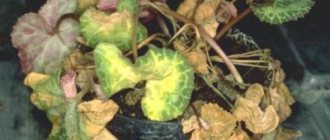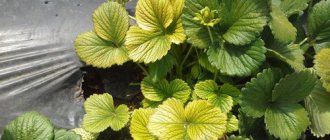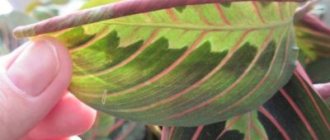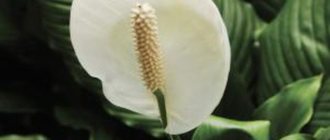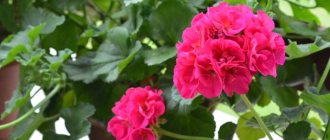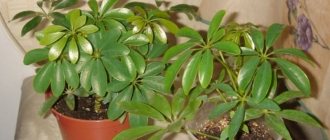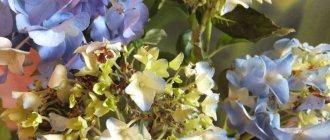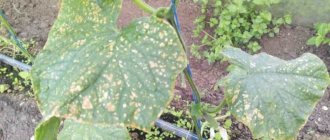Author: Natalya Category: Houseplants Published: May 28, 2012Republished: February 28, 2019Last edits: November 16, 2020
Every gardener knows that indoor flowers, like any living creature, require constant attention, care and care. Today I propose to talk about a problem that sooner or later faces everyone who grows indoor flowers. We will talk about the reasons for yellowing of plant leaves. I do not mean the natural aging of leaves, which is manifested in their yellowing, but cases where the yellowing and loss of leaves is not normal for the plant. If the leaves turn yellow from old age, needless to say that this disease cannot be cured... So, why do the leaves of indoor plants turn yellow? Let's look at the main causes and ways to eliminate them.
Violation of growing conditions.
When growing indoor plants, it is necessary to take into account the lighting in the room ; if there is a lot of it and there is direct sunlight, they should be shaded. Or move them to a more different place. Be sure to take into account the temperature conditions for growing your chosen indoor plant. Many plants prefer warmer growing conditions; some can tolerate lower temperatures. It is necessary to pay attention to planting indoor plants and replanting them. During such events, the plant experiences stress. Since its growing conditions are violated and your indoor plant has to get used to the new conditions for some time after planting/transplanting .
Watering a houseplant and feeding is perhaps the main point in growing it. Some species are not allowed to overdry the earthen ball, while others react painfully to excess moisture. If the norms and characteristics of watering are violated, problems with the appearance of diseases may arise . Pests can also cause harm .
Regardless of the reasons that arose when growing a houseplant, any change or violation of conditions is primarily reflected in the appearance of the leaves (this especially applies to decorative foliage indoor plants). The leaves may turn yellow, become spotted, simply begin to fall off, and may be affected by pests and diseases. The decorative component of a houseplant may also be lost if it becomes cramped in its pot and it has grown too much out of it.
The falling of leaves of indoor plants does not mean that it is dying or sick. It is necessary to take into account the natural death of leaves during development and growth.
Methods to combat the problem
If only the lower leaves have turned yellow, you don’t have to worry too much, but measures should still be taken. When we are talking about recently planted seedlings, and all the given reasons are clearly absent, you just need to tear off these leaves over time, the process of development of the bush will almost never stop. When the lower leaves turn yellow at the time of fruit ripening, this is also normal. After all, the bush itself is trying to get rid of what the gardener himself should have already done: at this time, the lower leaves only get in the way, drawing on the plant’s resources instead of the plant directing them to ripening the tomatoes. It is better to trim these leaves with scissors, although this is often done by hand; It is important not to damage the stem during the operation.
But in any case, you should make sure that the yellowing of leaves is a physiological process and not associated with flaws in agricultural technology (with mass yellowing, we cannot talk about physiology). Therefore, you should find the cause and try to eliminate it:
- establish a watering regime (water only in the morning or evening, with not too cold water, without fanaticism);
- carry out fertilizing (possibly extraordinary, including foliar feeding);
- When a diagnosis of “fusarium” is established, you can try to save some of the plants by treating them with Trichodermin or Previkur according to the instructions for the drug.
In severe cases, there are, of course, no guarantees of maintaining full health, much less a high yield, but at least something should remain in the beds, we must try.
Video: what to do if the leaves of tomatoes turn yellow
Lighting and sun
Light plays an important role in growing plants at home. This point is especially important for plants with variegated and colorful foliage. With insufficient lighting, the variegated forms of indoor plants become duller. In bright and strong lighting - especially if we are talking about the sunny side of your house. Direct sunlight can cause sunburn on leaves. At the same time, brown spots appear on the leaves, which can destroy the basic structure of the leaf and cause it to wither and further fall. If there is insufficient lighting, the shoots stretch out, bend, and due to the fact that they are thin, the leaves may fall off and the shoots may break. For indoor flowering plants, flowering stops or is reduced.
Solution to the problem: in case of insufficient lighting, you can use additional lamps or use phytolamps. But in bright sunlight, we shade the plant and move it to a place where there is no direct sunlight.
Why leaves on indoor plants turn yellow - you can understand the reason only after analyzing the condition of the plant.
Temperature
Temperature is very important, especially considering the tropical origin of many decorative foliage, flowering indoor plants. Maintaining a stable and constant temperature is the key to good development. If the air is dry, the tips of the leaves may dry out. With sudden changes in temperature, which can be caused by drafts or differences between the heating and the window frame, problems with leaves and inflorescences also arise.
Solution to the problem: avoid sudden temperature fluctuations. Avoid drafts (especially when ventilating the room). Try to choose the very place in which your flower will feel ideal. If the air is dry, we use air humidifiers or wet spraying; you can also wipe the leaves with a damp cloth. When spraying flowering plants, try not to get moisture on the inflorescences, otherwise they will begin to become stained.
Is it possible to remove such leaves?
One of the important points in the situation with yellowed and drying leaves is their removal .
How to remove leaves from an orchid? During the period of replanting an orchid, this question usually does not arise, since almost all damaged, dried and non-viable parts of the plant must be removed.
In a situation where it is too early to replant, you should carefully consider the process of removing the drying leaf. First of all, you need to check the drying phase.
If the leaf is not completely dry, it should not be removed, as it continues to nourish the plant. Only after complete drying and strictly according to the rules - it is removed carefully, trying not to damage the delicate trunk.
Drying of the leaf surface occurs unevenly and can continue for quite a long time; it is necessary to wait until they are completely dry.
Planting and transplanting
When purchasing a houseplant, it must be replanted in a permanent location. If your flower is old enough and its roots no longer fit in its pot, it should be replanted. For young indoor plants, it is enough to replant them once a year, but for older ones - once every three to five years. First, we take it out of the pot, and then plant it in a new one. Any disturbance in the root system is always reflected in its leaves - they begin to either dry out and fall off, or curl, dry out and fall off.
Solution to the problem: when planting or replanting, we try to minimize disturbance to the roots. If you have purchased a plant, carefully remove it from the pot and without breaking the earthen lump, place it in the same condition in a new pot. Try not to disturb the integrity of the root system that has already formed and is intertwined with the soil. Damp soil holds roots together better than dry soil. When planting or transplanting, the roots can be treated with a root formation stimulator (kornevin). When watering, you can use products such as epin, zircon.
How to save flowers
Leaves can turn yellow for various reasons; our further actions should be to save our “green pets”. Damaged leaves should be cut off immediately. Try to find the true cause of yellow leaves on flowers.
In case of infectious diseases and illnesses from pests, it is best to transplant the flower into new soil, having previously treated the plant.
Pour the roots with a weak solution of potassium permanganate, and treat the sections with activated carbon powder. Remove pests with various types of chemicals, specially designed individually for each type of harmful insect. Careful care of sick plants will give new life to your flowers.
Watch also the video on the topic:
Watering and fertilizing
This issue should be approached very carefully. All indoor plants tolerate excess moisture and drying out of the earthen ball differently. Therefore, the watering regime is selected individually for each plant. Stagnation and too wet soil leads to rotting of the root system and greatly affects the leaves. They begin to turn black and gradually dry out and crumble. It’s the same story with the drying out of the earthen coma. The leaves begin to fade and gradually fade. An excess of moisture or a lack of it affects the roots of the plant, hence the problems with the leaves. Because the watering conditions are violated. As for feeding, its lack can affect the development of shoots and leaves. They may become smaller and develop poorly. Also, a lack of certain nutrients may be reflected in the leaf itself. Too much fertilizer can also be harmful. Variegated forms - often acquire a green leaf color. For flowering indoor plants, a lack or excess of fertilizing affects the timing and quality of flowering.
Solution to the problem: control watering and fertilizing. When planting, the pot must have good drainage. If there are not enough drainage holes in the pot, make additional ones. If your planter or pot has an automatic watering function or combines both a planter and a container for planting at the same time. Watering is controlled. The soil should have time to dry a couple of centimeters before each subsequent watering. You can determine the need for watering using special devices to determine humidity. There are devices that will indicate to you the need for watering and soil fertility. Or you can check the soil moisture with a match - it should be stuck into the soil and, if there is soil left on the match, you should wait a while with watering.
But I advise you to carry out fertilizing within the specified time frame (active growth and vegetation of the indoor plant). We also take into account the resting phase of other plants. Always study the instructions and fertilizer rates. It is better to reduce the dose a little rather than give more. Excess fertilizer or a strong solution can burn the root system and cause harm. Use liquid mineral and organic fertilizers for indoor plants, which can be diluted in water for irrigation.
Pests and diseases
Both are the cause of violation of growing conditions. Diseases, and in particular fungal diseases, can appear in the pot if watering is not correct. Pests can appear when the plant weakens, when they are introduced with the soil or from another plant. Sometimes pests or diseases may already be present on the plant when it is sold.
Solution to the problem: diseases are mainly associated with the root system. Root rot can form when moisture stagnates, then it spreads to the shoots and trunk. If you do not notice the problem in time, you can lose the plant. As a preventive measure, in the early stages of the problem, let the earthen coma dry well. Next, we use the appropriate medications. It’s the same with pests – when we detect them, we take all necessary measures for control and prevention. In case of partial infection, we use appropriate preparations; in case of severe infection, we move the plant to a separate place and quarantine it. Using the necessary pest control product.
Types of diseases and pests of indoor plants
Aphids - the foliage begins to turn yellow and curl. When affected by aphids, young leaves may also turn yellow. The main feature of this pest is its ability to fly from plant to plant. Aphids are especially active during dry periods. In indoor conditions it is unlikely to appear, but when the room is ventilated, it can enter the house from the street. We carry out regular spraying, you can use a soap solution (for mild damage), or special preparations.
Nematodes - mainly live in the roots of the plant. They feed on ficus sap and, if damaged enough, the leaves begin to wither and then fall off. It is quite difficult to identify such pests; you need to inspect the top layer of soil. If a plant develops new shoots from the roots, they may not look entirely healthy (weakened or twisted, the leaves on such shoots are poorly formed and do not open completely). To prevent and control this pest, we use an insecticide. If necessary, the plant can be transplanted into new soil by treating both the roots and the soil with appropriate preparations.
Scale insects are small, cinnamon-colored insects. They got their name due to their shape - they look like they are in a shell. Just like with other pests that use plant sap for nutrition, we use appropriate preparations.
Mealybugs are very difficult to remove, so we constantly inspect the plant; this pest can be detected by noticeable discharge on the plants, they are very reminiscent of cotton wool. First, collect them with a cotton swab. And we treat the plant with a soap solution and appropriate preparations. We carry out the treatment constantly, since these insects hide in the axils of the leaves, and it is very difficult to get them out.
Spider mites often attack most indoor plants. This is facilitated by dry air and warm temperatures. The pest is identified by the presence of spots on the foliage. They are white or yellowish. The danger of such a pest is that it is difficult to detect and, if you miss this moment, the damage to your indoor plant will be very severe. We use various insecticides, it is advisable to alternate treatments, since any drug is addictive. You can solve the problem of dry air by constantly spraying the plant or using a humidifier.
Thrips - when infected by this pest, the leaves fall off. Favorable conditions for development are warm temperatures and dry air. A very nimble pest, if not noticed in time and missed, can infect nearby plants. This pest can only be controlled with special preparations (insecticides).
Root rot is caused by fungus growing in the soil. Fungi may already be present in the soil used for planting. And since fungal diseases begin to develop well in high humidity, damp soil, and warm temperatures, the development of this disease begins in the roots. The plant's reaction will be reflected in the leaves, which begin to turn yellow and then fall off. The result is the same - monitor the watering regime. If you have flooded the plant too much, try to let the earthen coma dry out; if it is severely infected, it will not be possible to save it. We throw away both the plant and the pot.
Leaf spotting can be expressed as either dots or spots. Infected leaves are removed, and the entire plant is sprayed with special preparations or a soap solution.
To summarize, I would like to say that any disease can be prevented, to prevent any diseases and the appearance of pests. Inspect your plant frequently for diseases and pests. If they are detected, we immediately begin treatment and preventive methods of control. Use various drugs to fight. Good luck to you.
What to do to stop yellowing?
The method of dealing with yellowed leaves will depend on the reasons that caused this problem. There may be several factors:
- improper care;
- insufficient feeding;
- presence of pests;
- infectious diseases.
Special means
Specialized products can help only in cases where the leaf blades turn yellow due to insufficient feeding, the appearance of pests or an infectious lesion. Be sure to determine the cause so as not to destroy the plant with improper treatment.
The following compositions can help overcome yellowness:
- fungicides (fighting infections and fungi);
- feeding preparations (depending on which element the flower lacks);
- insecticides (control of insects and pests).
In order to protect both yourself and the plant, consult a specialist. He will tell you which drug to choose in a given situation.
Traditional methods
Traditional recipes can only help in certain cases. For example, when there are initial signs of a plant being damaged by pests.
What should be done:
- First, isolate the damaged flower from healthy specimens.
- Remove all damaged leaves and stems with clean and treated pruning shears. They can no longer be saved, so treatment will be of little use.
- Spider mites, which infect indoor flowers more often than other insects, do not tolerate humidity. Give the plant a warm shower.
- Wipe the leaf plates with soapy water and then rinse thoroughly with clean water.
- Wrap the container with the flower in a bag and place it in a sunny place.
- After a couple of days, open the greenhouse and wash the window sill thoroughly with soap to destroy any remaining pests.

